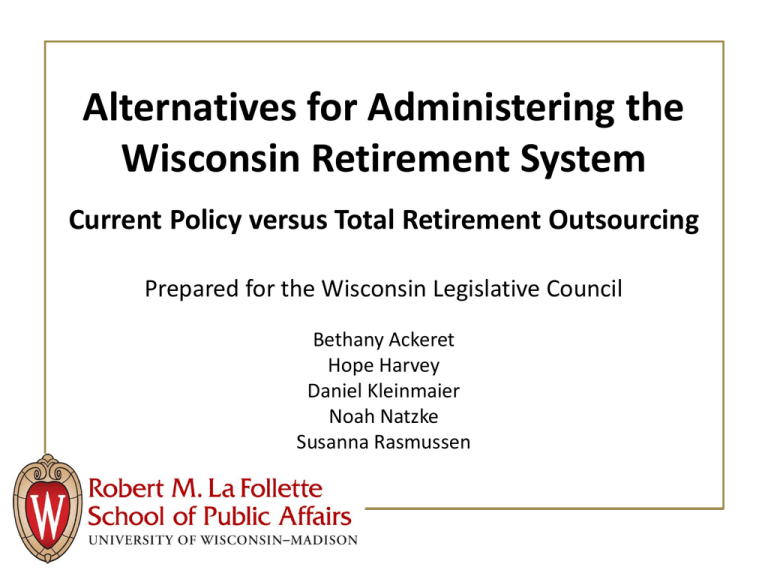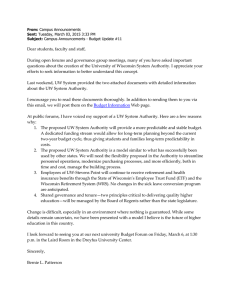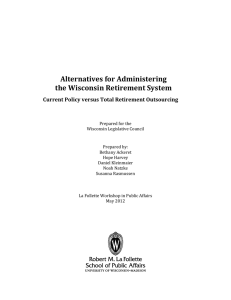Alternatives for Administering the Wisconsin Retirement System
advertisement

Alternatives for Administering the Wisconsin Retirement System Current Policy versus Total Retirement Outsourcing Prepared for the Wisconsin Legislative Council Bethany Ackeret Hope Harvey Daniel Kleinmaier Noah Natzke Susanna Rasmussen Agenda • • • • • • Project Summary Overview of Wisconsin Retirement System Privatization Definition Policy Alternatives Analysis of Alternatives Recommendation Project Overview & Aims Project Summary • Question: Should the WRS be privatized? • Analysis of two options: – Current WRS policy – Complete outsourcing of WRS to private firm • Complement to the forthcoming report on a defined contribution option Structure of the WRS Wisconsin Retirement System State of Wisconsin Investment Board (SWIB) Department of Employee Trust Funds (ETF) Manages invested retirement system assets Provides day-to-day benefits administration for WRS Framework for Decision-Making • The WRS is a trust • State statutes dictate that ETF and SWIB board members are fiduciaries of the trust • Must enact management decisions that result in the lowest responsible cost • Decisions regarding privatizing functions are dictated by this responsibility ETF: Summary • Retirement, health, life, income continuation and long-term disability benefits • Duties: – Collects retirement funds; remits to SWIB – Calculates disbursement of payments – Provides information to participants and employers SWIB: Investment Strategy and Approach • Board of Trustees establishes investment policy • Day-to-day investment decisions must fall within the parameters of the policy • Day-to-day decisions made by SWIB in-house professional investors or external private firm professional investors Levels of Assets Invested by SWIB In-House Investors • • • • 2007: 21% invested by SWIB investors 2009: 41% invested by SWIB investors 2010: 47% invested by SWIB investors Increase in internal investment resulted in estimated net annual savings of $13 million in 2010 Source: State of Wisconsin Investment Board, 2011 CEM Benchmarking, Inc. Evaluation • The WRS Core Fund five-year total return of 5.0 percent was above the peer median of 4.5 percent • The WRS Core Fund had a lower cost than peers by 17 basis points on average (without adjusting for asset mix differences) Hopkins, 2011 Source: CEM Benchmarking, Inc., 2012 Privatization Definitions • Scaling back of direct government action • The expansion of subsidies for private insurance, savings, and charitable activities • Use of vouchers that provide opt-out alternatives for the public service • Expansion of government contracting Policy Alternatives 1. Piecemeal Outsourcing (current policy) 2. Total Retirement Outsourcing: Contracting with a single private sector firm to administer the WRS Piecemeal Outsourcing • SWIB outsourced 52.7 percent of investment in 2010 (currently approximately 45%) SWIB Management Costs SWIB Asset Management 11.3% 47.3% 52.7% 88.7% Internal External Internal External • ETF outsources administration of IT services and actuarial services Reasons for State Privatization (1998-2002) Percentage of Responding States 70% Cost Savings 60% Expertise 50% 40% Flexibility 30% 20% 10% 0% Speedy ImplemenHigh Quality tation Service Political Increased Leadership Innovation Reason for Privatization Source: Chi, Arnold, & Perkins, 2004 Policy Goals 1. 2. 3. 4. Reduce Costs Enhance Service Have a Positive Economic Impact Be Feasible Reduce Costs GOALS Impact Category Current Policy: Piecemeal Outsourcing Total Retirement Outsourcing Profit Motive Costs Excellent Poor Competition Fair Poor Economies of Scale Fair Good Transition Costs Excellent Poor REDUCE COSTS Enhance Service GOALS ENHANCE SERVICE Impact Category Current Policy: Piecemeal Outsourcing Total Retirement Outsourcing Level of Service Good Poor to Fair Level of Accountability and Control Excellent Poor Risk Minimization Excellent Fair Economic Impact GOALS ECONOMIC IMPACT Impact Category Current Policy: Piecemeal Outsourcing Total Retirement Outsourcing Employment Effects Good Poor Distributional Effects Good Fair Feasibility GOALS Impact Category Current Policy: Piecemeal Outsourcing Total Retirement Outsourcing Political Feasibility Excellent Poor Legal Feasibility Excellent Fair FEASIBILITY Recommendation • Our report demonstrates superiority of Current Policy • Reduced costs, level of service, economic impact, and feasibility ranked lower for Total Retirement Outsourcing • Current WRS lauded as low-cost, highperformance For further information Contact the La Follette School’s publications office at 608-263-7657 or publications@lafollette.wisc.edu Or see www.lafollette.wisc.edu/publications/workshops.html Thank you! Policy Alternatives in terms of Policy Goals GOALS Impact Category Current Policy: Piecemeal Outsourcing Total Retirement Outsourcing Profit Motive Costs Excellent Poor Competition Fair Poor Economies of Scale Fair Good Transition Costs Excellent Poor Level of Service Good Poor to Fair Level of Accountability and Control Excellent Poor Risk Minimization Excellent Fair Employment Effects Good Poor Distributional Effects Good Fair Political Feasibility Excellent Poor Legal Feasibility Excellent Fair REDUCE COSTS ENHANCE SERVICE ECONOMIC IMPACT FEASIBILITY



